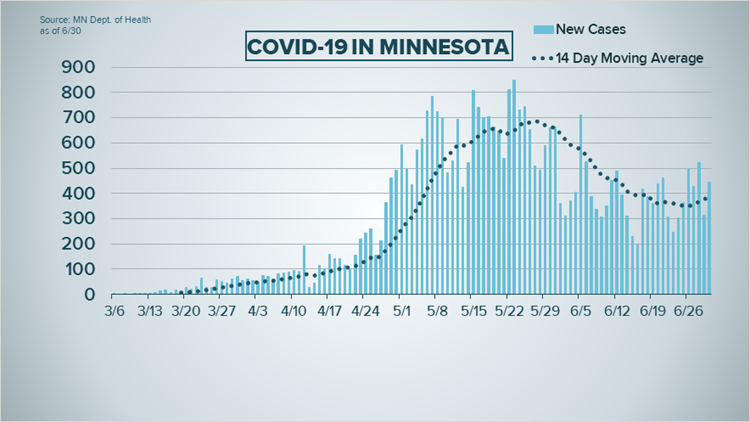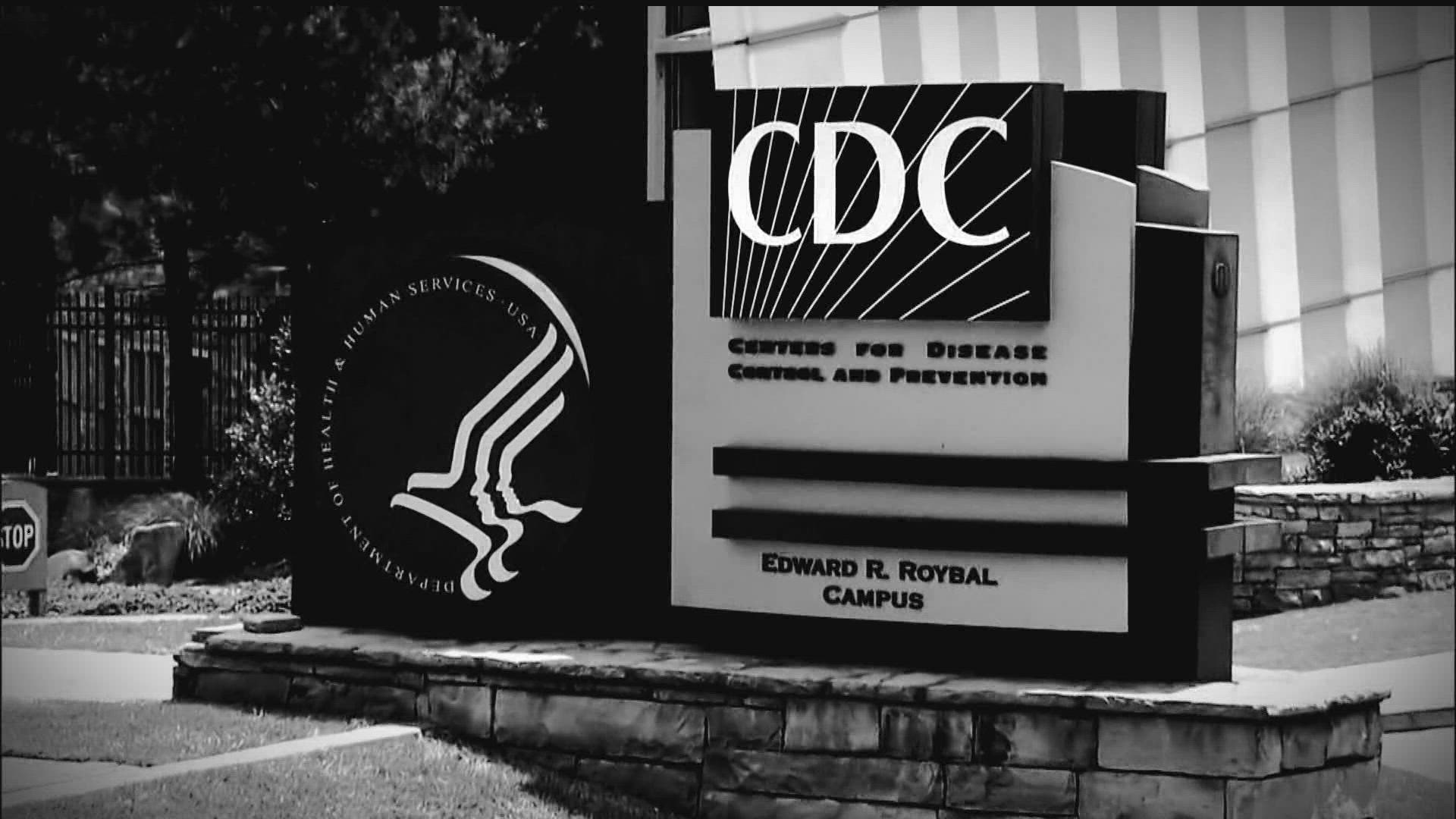ST PAUL, Minn. — Tuesday, June 30
- Minnesota hits capacity to test 20,000 per day for COVID-19
- COVID-19 deaths hit double digits for first time in over a week
- Hospitalizations due to coronavirus lowest in two months
11 a.m.
New numbers released by the Minnesota Department of Health (MDH) reflect the trend of fewer COVID-19 hospitalizations, and a return to single-day deaths in the single digits.
Health officials say 444 Minnesotans tested positive for the coronavirus over the past 24-hour collection period, bringing the total number of confirmed cases to 36,303 since the onset of the pandemic. Private labs processed an additional 12,705 tests, bringing the total to 605,316.
In the past day 6 Minnesotans died from complications of COVID-19, pushing fatalities to 1,441. Of those deaths 1,131, or 78%, occurred in long-term or assisted living care facilities.
Hospitalizations continue on their downward trend with 270 people currently requiring in-patient treatment. Of those patients, 136 have symptoms serious enough to require treatment in the ICU.
MDH says 31,601 people who at one time tested positive for the coronavirus have recovered to the point they no longer require isolation.
People between the ages of 20 and 29 make up the largest group of confirmed cases with 7,675 testing positive. Health officials have referred to this group as the most social in Minnesota, and have urged them to take precautions when going out to bars and gathering spots. Those between 30 and 39 account for 7,145 cases. People between 80 and 89 make up just 1,559 cases, but 492 of the state's total fatalities.
Monday, June 29
2 p.m.
Gov. Tim Walz held a news conference to announce a COVID-19 “testing milestone” on Monday.
Walz said the state now has the capacity to test 20,000 Minnesotans per day, a "moonshot" testing goal that the governor has been talking about for months. Walz referenced the initiative that the state, the University of Minnesota and the Mayo Clinic announced in late April.
“It put us in a position to be able to have an accurate representation” of the virus’ spread in Minnesota, Walz said.
He said the testing initiative has also allowed them to build up contact tracing after identifying positive COVID-19 cases.
"We’re going to need to be able to test, trace and isolate until we have therapeutics and a vaccine," Walz said. He said he doesn't believe the projected 18-month timeline for that process has changed.
"We've going to have to learn to live with and manage COVID-19 for quite some time," he said.
Walz emphasized that testing does not create more COVID-19 positivity, but more cases are identified when testing rates go up. To develop an accurate picture of the state of COVID-19 in Minnesota, he said his team looks at positivity rates day to day.
“I think Minnesota’s approach to this gives us a greater ability to weather over the long haul," Walz said.
MDH Commissioner Jan Malcolm said in general, state officials are still seeing an "up and down" pattern with new cases. Saturday's most recent "peak" was 520 cases, the largest number since June 4. The 235 cases identified a week before that indicated the most recent "valley," Malcolm said.
Malcolm said Minnesotans should keep in mind that the new cases seen on any given day reflect exposures that occurred two or three weeks ago. For these reasons, she said MDH expects cases to go up soon.
"We’re seeing more social gatherings and we’re seeing second-generation transmissions,” she said. "We are all a part of this transmission chain and we all need to act accordingly."
Malcolm said that being outside helps, social distancing helps, and wearing a mask helps.
"Being outside is a good thing. The risk of transmission outside, the data is becoming more and more clear, how much better that is," she said.
Malcolm urged people to continue to follow public health guidance to protect others they come into contact with.
"This is about the potential, more than the potential, the fact of transmission between people that don't even know they have the virus and other vulnerable people," Malcolm said. "To the extent anyone thinks this is over ... it is most assuredly not."
Currently, Minnesota's case positivity rate is 4.4% on a seven-day average.
Over the last week, Malcolm said, an average of 11,240 tests were performed each day across the state. That volume was an increase of 16.4% from testing the previous week.
“This puts us in a position that many other states don’t have,” Malcolm said. “The ability to actually execute on that goal has been full of challenges for literally every state in the country. I think our progress has been more durable because of the partnership that we’ve established here.”
The state has been encouraging anyone who is symptomatic to be tested, and has posted a map of testing locations online. Malcolm also said that they'll be launching initiatives to do more targeted testing in underserved populations, such as urban and indigenous communities.
When asked about the potential of the state mandating that the public wear masks, Walz said "everything's on the table" and that topic is "coming up."
"I'm serious about talking about it," he said.
Walz said he tends to prefer using the "carrot rather than the stick," but pointed out that wearing a mask has become a political or ideological decision instead of a scientific one.
"If you are for the economy opening up and for the state to take away some of the limitations on your business, the surest way to do that is to wear a mask," he said.
In response to questions about COVID-19 clusters at four Minnesota bars, Malcolm said there are clear requirements that include making sure customers are seated and not standing.
The "enforcement strategy" is typically that complaints are referred to a local law enforcement agency, which sends an officer to check out the situation at the bar or restaurant.
"We’ve been having conversations about how to make sure that that enforcement and that guidance is taken seriously," Malcolm said. "We’re talking about making it more clear to establishments what the consequences of failure to comply is."
Malcolm said if the state sees more clusters, that could lead to "stronger mitigation measures."
"That educational approach doesn’t seem to be having all the impact that we want it to,” Malcolm said.
Walz acknowledged that "bars are hot spots."
"At some point in time the carrot turns to a stick to stop this thing," Walz said.
KARE 11’s coverage of the coronavirus is rooted in Facts, not Fear. Visit kare11.com/coronavirus for comprehensive coverage, find out what you need to know about the Midwest specifically, learn more about the symptoms, and see what companies in Minnesota are hiring. Have a question? Text it to us at 763-797-7215. And get the latest coronavirus updates sent right to your inbox every morning. Subscribe to the KARE 11 Sunrise newsletter here. Help local families in need: www.kare11.com/give11.
The state of Minnesota has set up a hotline for general questions about coronavirus at 651-201-3920 or 1-800-657-3903, available 7 a.m. to 7 p.m.



